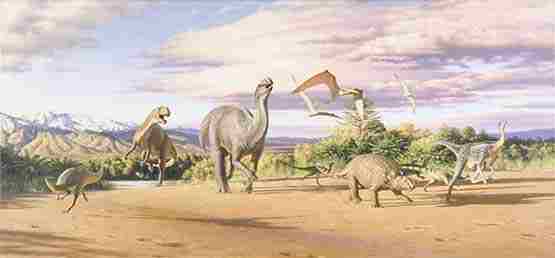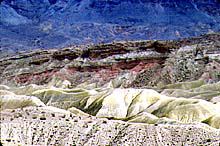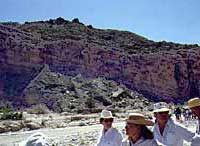
| | You are here : Home > Museums > Fossils Fossils : 
Studying fossils teaches us about plants and animals of the past, including our human ancestors. Go back in time and discover the stories that fossils can reveal, including the hunting habits of early humans and the oversized trees that used to dominate Britain. What is a fossil?
The remains (bones, teeth, skull) or traces (footprints, burrows) of something that lived in prehistoric times. This means that fossils could be 10,000 years old or as much as 3½ billion years old.Fossils can be mineralized bones, teeth, shells, wood, or actual unaltered material from an organism, like frozen mammoth flesh, bones and fur. Eggs, nests, footprints, leaf impressions, burrows, and feces are examples of trace fossils. One thing all fossils have in common, they are OLD, at least 10,000 years old. More > |
| Where Are Fossils? | 
Sediments are deposited in layers, sometimes burying traces of life. These sedimentary rocks are stratified. | The oldest known fossils are 3.5 billion years old. What's happened in the past 3.5 billion years? The Earth is a very old place, and it's always changing: changing landscape, changing seas, changing weather, changing life. Every plant, every animal, every fungus, every bacterium eventually dies. Maybe it gets eaten, partly eaten, or it rots. If it gets buried and preserved, a fossil is formed. Wherever you are, you might be standing on a fossil. |
| Where to Look for Fossils | 
The slanting strata of these sedimentary rocks shows that these rocks have been uplifted. | Geologic forces of uplifting and erosion can reveal long-buried fossils. Major events of uplifting occur when two plates of land on the earth's surface crash into each other. One plate goes under; the other goes up. Many mountains are formed through uplifting. Erosion happens when water or wind wears away bits of rock. The Grand Canyon is a huge example of erosion. The Colorado River and dusty winds carved through the many layers of sedimentary rock, the different layers telling fossilized stories of life on Earth. The deepest layers tell the oldest stories, because they were deposited first. For more information about How to Find Fossils More > |
|

